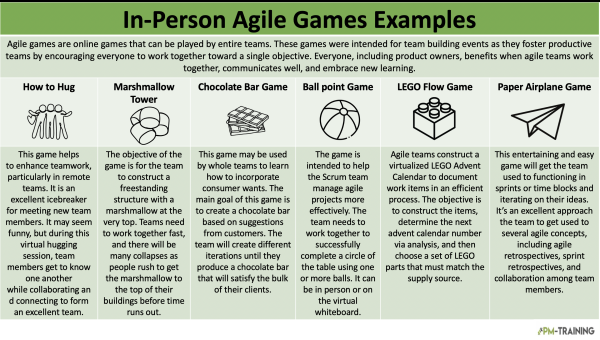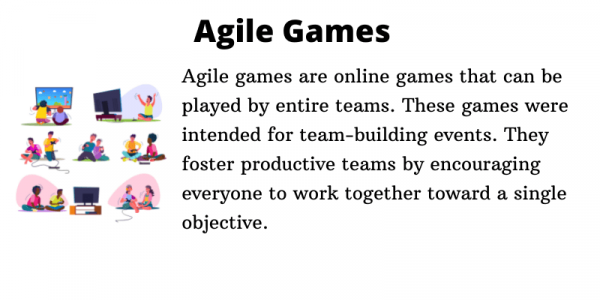Agile games are online games that can be played by entire teams. These games were intended for team-building events. They foster productive teams by encouraging everyone to work together toward a single objective. Everyone, including product owners, benefits when agile teams work together, communicates well, and embrace new learning.
Through team-building activities, team-building games foster creativity by fostering a fresh viewpoint.
Agile games are entertaining but also useful. Team members can change their behaviors thanks to this realistic approach. Teams improve their software development working techniques by playing agile games. Agile games help team development via novel learning activities and iteration.
Role Of Agile Games In Team Building
Agile games ultimately support DevOps teams’ effective communication and self-organization. Agile software is more quickly assimilated by your team members because of playing agile games. Agile teams get several advantages as they develop their problem-solving abilities that could have been lost if they hadn’t used an agile approach or these agile games.

You may introduce new teams to agile software by playing one of the many available games. Many of these easy games were created by Tastycupcakes as conversation starters to get introverts to engage more actively in Scrum processes. Any agile coach will be glad to employ these games since they also aid in the development of multitasking abilities in high-stress DevOps scenarios.
You’re undoubtedly eager to learn what kinds of games you can play to foster cooperation now that you have a foundational understanding of the theory behind agile games. To whet your appetite, check out these quick games. The games in this list, each with a different goal, range in playing length from the shortest to the longest.

How to Hug
| Time to Play | Format | Players Required | Learning Objectives |
| 5 minutes or less | Virtual | 3+ | Agile team collaboration |
Mechanism at Play
A simple agile game called How to Hug helps to enhance teamwork, particularly in remote teams. An excellent icebreaker for meeting new team members is How to Hug. This agile team-building exercise is accessible online to the Scrum team. Each member of the team submits a picture to be shown on the How to Hug virtual circle.
An individual from the group is selected at random to have their picture placed in the middle of the group’s circle. Next, everyone other in the team brings their own picture just in front of the one in the middle until their pictures are touching. Imagine a warm embrace being sent your way right now. Then, each member of the team takes it in turn bringing his or her own picture to the middle.
It may seem funny, but during this virtual hugging session, team members get to know one another while collaborating and connecting to form an excellent team.
Marshmallow Tower
| Time to Play | Format | Players Required | Learning Objectives |
| 20 minutes for one round | In-person only | 4+ | Iteration and Collaboration |
Mechanism at play
This one-of-a-kind agile game will have your agile group working together to construct something. You’ll have them form four-person teams, and then give each group 20 strands of spaghetti, a yard of tape, a yard of twine, and a marshmallow. The objective is for them to construct a freestanding structure with a marshmallow at the very top.
Although the idea is straightforward, putting it into practice may be challenging. Teams need to work together fast, and there will be many collapses as people rush to get the marshmallow to the top of their buildings before time runs out. However, if the challenge is given several times, teams will learn to improve their cooperation techniques and prototypes.
Chocolate Bar Game
| Time to Play | Format | Players Required | Learning Objectives |
| 5 minutes | In-person and virtual | 4+ | A team-building exercise for iteration and customer feedback |
Mechanism at play
The Chocolate Bar Game is perfect for new teams who have no experience with agile methodologies. As the team plays this game and gains more iteration knowledge, teamwork increases. This game may be used by whole teams to learn how to incorporate consumer input into retrospectives. The game can be played live in person or virtually with different teams.
The main goal of this game is to create a chocolate bar based on suggestions from your customers. All other members of your team will be customers, and your team will choose one individual to serve as the product manager or product owner. The product manager’s job is to develop a chocolate bar that consumers will like. They may choose the kind of chocolates (white, milk, or dark), the fillings, the toppings, and any other unique features such as whether the chocolate is gluten-free or organic.
Each iteration provides the product manager an opportunity to get client feedback on various aspects of the chocolate bar. Customers will be asked to rate each variety of chocolate in the first round by giving them a thumbs up or down. Then they’ll continue to the following stage, where they’ll inquire about fillings, after making a final choice and writing it down. They will continue until they have produced a chocolate bar that will satisfy the bulk of their clients.
Ball Point Game
| Time to Play | Format | Players Required | Learning Objectives |
| 5+ minutes (three-minute sprints) | In-person & virtual | 4+ | Agile production process |
Mechanism at play
The Playing Ball Point is intended to help the Scrum team manage agile projects more effectively. The team has a better knowledge of the agile production process and recognizes the value of self-organization. For Scrum methods to be successful and allow for efficient iteration by the whole team, self-organization is the key building block. This game can be played by whole teams in person or online using the game symbols on the virtual whiteboard.
The objective of the game is for the team to work together to successfully complete a circle of the table using one or more balls. Players on a team are only allowed to touch the ball(s) once. Once a teammate touches the ball, the following player in line must do the same. If the Scrum team can successfully move the ball around the table, they will be awarded a point.
Each sprint lasts three minutes, and the winning team in Ball Point will be determined after five total sprints. It is common practice for teams to strategize and make strategies during the first sprint to estimate how many points they will score for the first minute. Within the second minute, you will be tasked with moving the ball on the table. In the third minute, the Scrum team records their progress and any new learnings they’ve gained.
As players continue to add additional balls in the next sprint rounds, teamwork becomes increasingly intense. Game complexity increases when the team passes balls at the same time. In order to improve their scores, the team members must think more throughout the iteration phase. The teams do a quick retrospective after each round to see what strategies they might use to win the following sprint with a larger margin of victory. It’s a simple game but effective!
LEGO Flow Game
| Time to Play | Format | Players Required | Learning Objectives |
| 60 to 90 minutes | In-person only | 3-9 | Workflow, iteration, collaboration, and Scrum |
Mechanism at play
The Lego Flow Agile Game is a fun exercise that focuses on simulating Scrum. Agile teams construct a virtualized LEGO Advent Calendar to document work items in an efficient process. Each phase of the process includes a unique set of role players. The objective is to construct the items, determine the next advent calendar number via analysis, and then choose a set of LEGO parts that must match the supply source (suppliers).
As they advance in the game, the Scrum team constructs the LEGO items. To ascertain whether the build is accurate and deemed acceptable by market representatives or the product owner (acceptor), team members must continuously iterate. There are three rounds to the agile game LEGO Flow, and each has a distinct goal. The procedures used to achieve these goals include time-boxed, flow-based, batch, and phase-driven.
Sprint retrospectives are held at the end of each of the three iterations of collaboration to discuss the successes and failures of the previous iteration. The objective is to evaluate the pros and cons of each sprint methodology and show how working together might be advantageous. After a round is completed, a global Cumulative Flow Diagram is drawn.
This diagram enables the whole team to review its tactics and choices, reflect on where they made errors throughout each round of this agile game, and improve their process. If there is time, the Scrum master might ask team members what policy adjustments they would make for the next sprints.
Paper Airplane Game
| Time to Play | Format | Players Required | Learning Objectives |
| 45 minutes (nine-minute sprints) | In-person only | 4+ | Time blocks and iteration |
Mechanism at play
Everyone can make a basic paper aircraft. What if you’re attempting to design one that can go the furthest distance? This entertaining and easy game will get your team used to functioning in sprints or time blocks and iterating on their ideas.
Divide your team into groups and distribute stacks of paper to each group. Making as many paper aircraft as they can is their aim. Before delivering the sheet of paper to the next team member, each team member may only do one fold at a time. In addition, only planes that cover a minimum distance agreed upon by your whole team will score points.
The game will be divided into nine-minute sprints, with three minutes allotted for planning, three minutes for designing and testing, and three minutes for retrospection. Teams should estimate how many aircraft they will create before the time box starts so that they may assess their own performance during evaluations.
It’s an excellent approach for your team to get used to several agile concepts, including agile retrospectives, sprint retrospectives, and collaboration among team members.
There are many other agile games you may play with your team to assist in the understanding of agile ideas. The notion is that, in general, team-building exercises are focused on practical experiences that assist in empowering people to contribute to shared objectives and to create confidence in one another’s skills.
